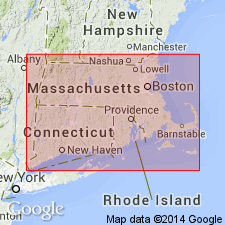
- Usage in publication:
-
- Leadmine Pond Gneiss
- Modifications:
-
- First used
- Dominant lithology:
-
- Gneiss
- Amphibolite
- AAPG geologic province:
-
- New England province
Summary:
Leadmine Pond Gneiss is a new informal unit, named for Leadmine Pond in Sturbridge, MA, where the largest section through the unit is exposed. It is also exposed in several thin, structurally isolated belts to the west. Unit is characterized by medium-gray to white plagioclase-quartz-biotite gneiss with interlayered biotite-rich gneiss and amphibolite. Contains subordinate thin units of schist, quartzite, granofels, sillimanite-bearing gneisses, and calc-silicate rocks. Rocks assigned to the Leadmine Pond were previously considered gneiss members interstratified with schists of the Hamilton Reservoir Formation. Interpretation here is that unit is Precambrian(?) to Ordovician(?) basement unconformably underlying Rangeley Formation.
Source: GNU records (USGS DDS-6; Reston GNULEX).
For more information, please contact Nancy Stamm, Geologic Names Committee Secretary.
Asterisk (*) indicates published by U.S. Geological Survey authors.
"No current usage" (†) implies that a name has been abandoned or has fallen into disuse. Former usage and, if known, replacement name given in parentheses ( ).
Slash (/) indicates name conflicts with nomenclatural guidelines (CSN, 1933; ACSN, 1961, 1970; NACSN, 1983, 2005, 2021). May be explained within brackets ([ ]).

